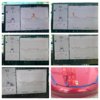Now let's look at 3P-20" energy consumption at highway speeds. With no wind, just increasing the speed from 75 to 79 mph increases consumption by 6.6%. Decreasing speed from 75 to 71 mph decreases consumption by 6.2%.
Now let's have this car stay at 75 mph but add a 4 mph straight-on headwind. Energy consumption increases by 10.7%. With a 4 mph tailwind, consumption decreases by 9.6%. I was surprised at this. That's a large effect! I rechecked my old spreadsheet, as one does, and it all seems to check out. Fundamentally, what happens is that the car spends more time with the higher aero drag than it would if just traveling at the higher speeds. Energy consumption is energy used over distance (Wh/mi). In this example, the car spends 5.3% longer traveling at 75 mph vs 79 mph to go the same distance.
For those curious, a 10 mph headwind while driving at 75mph increases energy consumption by about 29% and a 10 mph tailwind decreases it by 22%. If you do a round-trip test by driving into a 10 mph headwind, then return with the tailwind, just averaging those results introduces a 3.5% error [(1.29+0.78)/2].
There are so many variables it is very difficult to figure out expected efficiency - especially at freeway speeds. And temperature seems to make a surprisingly large difference even if the HVAC is off...
1) Yes, power to overcome drag goes up as the
cube of velocity. But sadly in the case of wind we don't get to "lose" one of those powers (and just get the standard "Wh/mi increases proportional to square of velocity" by reducing the time over which the power is exerted). (As your numbers show, energy to complete a standard trip does not simply scale by the square of the velocity, of course, since aero loss is not the only thing...since there are some losses that are fixed per unit distance, and others that are fixed per unit time (and go down the faster you go).)
2) Yes, round trip with wind doesn't "cancel out", due to the nonlinear nature of the losses. For the same reason, average speed on a trip is often misleading - especially if most of what pulls down the average is very slow travel (typical for freeway runs with brief surface streets before/after). In these cases, it's hard to calculate the effective speed to use, but generally you should quote your typical freeway speed.
3) If you want to see historical wind data for a particular trip, you can visit:
NWS Weather & Hazards (This is centered on San Diego (SGX), but you can pan around or use your local weather service station code.) Click on a weather station and you can easily see 3 & 7-day historical data.
Anyway, here is data from a 26-mile round trip generally north/south - though about 25% was into/out of the wind, from above website, winds were about 2-4mph from the
west - was hard to notice the impact since the outboundwhich was partially east was also slightly downhill)
Round trip (as close as exits allowed), P3D+, stock:
Average speed
71mph
Freeway speeds (vast majority of time):
75-80mph
Distance: 26.3 miles
Time: 22 minutes
Net elevation change: -13 feet (from Gaia GPS: +742 ft, -755 ft) (No hills came close to regen so minimal impact)
Wh/mi:
275Wh/mi
HVAC basically off (some brief fan ONLY use)
Temp: 65-70 degrees, sunny
So I think this aligns pretty well with a true average speed of 75mph (with peak speeds more consistently at 75-80mph) ending up around 295Wh/mi (it might end up being a bit lower). It was a short segment but I did start the segment after the car had "warmed up" - so if there is any significant starting overhead that would have been excluded.









